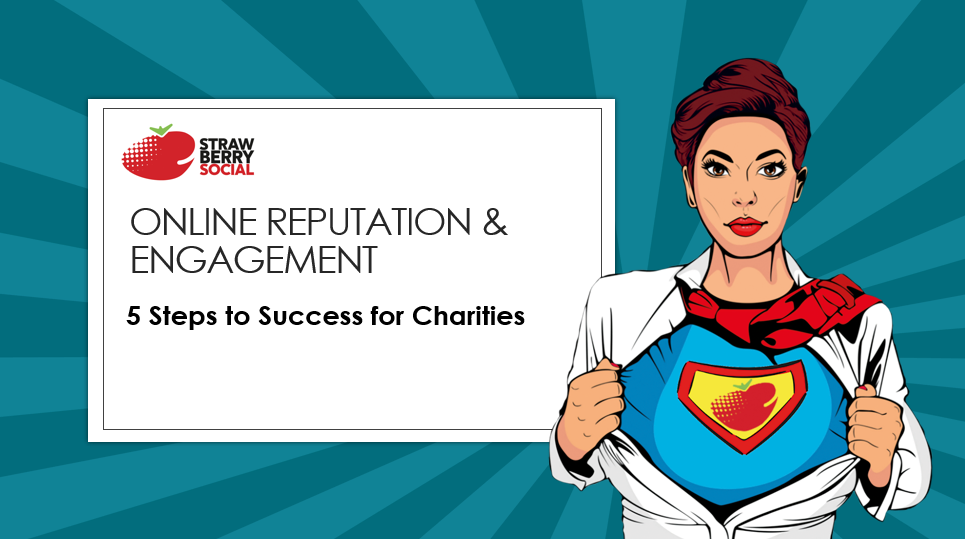
Online Reputation & Engagement: 5 Steps to Success for Charities
 November 26, 2021
November 26, 2021 StrawberrySocial Founder, Rebecca Fitzgerald, shared a phenomenal amount of best practice advice and tips on this important topic at the CharityComms Digital Conference recently. Here’s a summary of the key points for those who missed it.
There are 5 key areas to cover when it comes to online reputation and engagement.
- Persona
- People
- Safety & Responsibility
- Politics & Divisive Topics
- Budget
1. Persona

Your charity’s story is a huge part of its reason for existing and is its appeal but have you taken this story and translated it into not only what your online persona looks like but how it behaves?
It’s important that your voice and the support you offer is consistent both on and offline. How do you want to be perceived and what help does your audience need?
Invite some followers to a research session, ask them questions as to what they want to see and how they want you to approach them and share information.
Ensure you have a clear stance on key topics such as #MeToo, #BLM and LGBTQ and have messaging agreed and in place.
2. People

Think about all the people who represent your organisation, from employees and suppliers, to volunteers, celebrities and influencers.
Do you have a clear social media policy in place for employees, volunteers and suppliers? Have you done due diligence checks on the celebrities and influencers you work with?
Get ahead of any PR issues that may arise in future. Ensure you have social media policies, robust contracts, and DBS checks in place. Do a deep dive on the people who make up your organisation, with the help of your HR department. If you don’t, you can be sure others will.
3. Safety & Responsibility

You have a duty of responsibility to your audience. Especially if it’s a vulnerable one.
Consideration for mental health is key for many charity audiences – illnesses and disabilities place a huge strain on both sufferers and those around them. Your first escalation workflow and approach could focus on this.
What type of posts might you see? Categorise them and then build a workflow around this – we use ‘Important’, ‘Serious’ and ‘Emergency’ to define different levels of approach.
4. Politics & Divisive Topics
Everyone has an opinion and that opinion is magnified (and very often undiluted) on social.The good news is there are ways to spot issues coming and be prepared to deal with them and even cut them short.
You need to have a clear idea as to exactly what your organisation stands for and, then, list the reactions that may result. Have a ‘line’, an approach for each one. And have it signed off in advance.

Make a list of everything that you could see going wrong. Brainstorm this in a room with colleagues. think of everything from small everyday niggles up to the worst-case scenarios.
Look at what you’ll allow users to discuss. If you set your rules out clearly and maintain them, useful conversations can take place. Be consistent with how you engage and monitor all conversations. This will help the audience know where you’ve set the limits and will know when they chose to break them.
Make a list of the activist groups and individuals who are vocal and have an opposite view to you or have a history of causing trouble. You can set up a moderation tool to flag up potential trouble. Hootsuite is a good tool for monitoring keywords and isn’t expensive.
Read our top 5 tips on dealing with the dark side of social >
A word on workflows:
- Always have clear workflows for all risk elements and how they can be dealt with.
- Look at examples from other organisations. Review what they did and learn from them (the good and the not-so-great).
- Have these workflows maintained and updated regularly by a central person/team.
- Require regular reviews from all involved. You could set up a monthly quiz to refresh understanding and to keep the information top of mind.
- Log all outcomes and learn from them.
5. Budget

Always have regular moderation coverage and a bank of emergency hours as a line items in your annual budget. It’s easier to have it pre-approved than it is to try to source it during an emergency.
Look at your campaigns across the year and learn from them. What moderation support did you need and what did it cost? Build that in each year, allowing for planned campaigns, challenge groups or upcoming big events.
Hungry for more helpful Online Reputation & Engagement content? Check out some of our other blogs:
…And stay tuned for a link to the video presentation!
Check out our services:
Community Management and Customer Support
Charity Support


 Share This Post
Share This Post